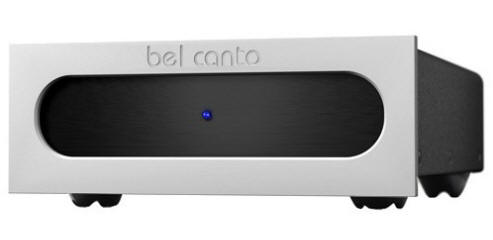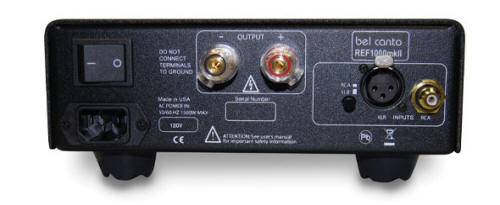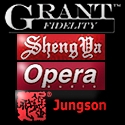
You are reading the older HTML site
Positive Feedback ISSUE
43may/june 2009
bel canto
REF1000 MkII amplifiers
as reviewed by Guido D. Corona

|
During RMAF 2008 in Denver, CO, upon discovering the captivating sound in suite 586 at the Tech Centers Marriott Hotel, I had a sudden feeling that the newest creations of Bel Canto Design warranted a very careful audition. After listening for several hours to the expansive sound stage, presence, and filigreed musicality in the suite, I decided that my first impression may not have been delusional after all, hence I proposed to John Stronczer—Bel Canto's CEO—that I write a review of his newest monoblock amplifiers. My Vienna Mahler v1.5 speakers being admittedly power hungry, I opted for the REF1000 MkII monoblocks, bigger brothers of the delightful REF500 monos featured at the show.
The REF1000 MkIIs were delivered to my home solidly packed in dense foam, and individually double boxed, with each inner shipping case sporting a side handle, reminiscent of the shipping valises that protect many notebook computers. With a size of 8.5 x 3.5 x 12 inches, and a weight of 15lbs, each REF1000 MkII is a compact but hefty device, sporting an understated retro industrial elegance, thanks to the contrasting geometries of its heavy gage front silver Aluminum fascia, whose angular outer lines frames a large recessed central black ellipsoid. A blue LED in the very middle of the front face illuminates when the unit is operational, while a substantive power switch is a rocker mounted on the back plate. A 15-amp IEC inlet sits just below the power switch, while the balance of the back panel features a set of twin WBT 5-point safety binding posts, a single Neutric XLR socket, a high copper RCA connector by Sound Connections, as well as a pushbutton selector for switching from balanced to single ended operation. All fuses are internal to the amplifier, and can be accessed and replaced only by authorized technicians.
At a time of rising energy costs, and growing social concern for husbanding the finite resources of our planet, I welcome the REF1000 MkIIs extremely high power conversion efficiency of 79%. After the several weeks of continuous music making that I forced upon them during break-in, the amps were barely warmer than skin temperature. The low standby power consumption of only 15-watts bespeaks the amps' class D switching design, based on the exceedingly efficient ICEpower 1000 ASP power conversion modules. Yet, the Bel Canto REF1000 MkIIs are far from being mere raw ICEpower modules in handsome boxes. Like the core power conversion components imbedded in so many advanced amplifiers based on other underlying technologies, the ICEpower modules are but the central building blocks of a comprehensive design optimized to yield high musical performance.

To help dispel an increasingly stale urban legend about the allegedly flawed pedigree of class D amplification, it is worth pointing out that like other amplifiers of their kind, these are not digital devices. At their core, the analog switching technology of the B&O's ICEpower 1000ASP 500-watt power conversion module is essentially analog, and so are the related regulated power supplies. According to Bel Canto, the fully balanced input stage of the REF1000 MkIIs maximizes "high common mode noise rejection and wide dynamic range. "Furthermore, internal impedances have been optimized to reduce noise and distortion. Measurements reveal a full 6dB improvement in signal-to-noise ratio when driving the output amplifier section with low-impedance loads." The foregoing also implies that, combined with their very high damping factor of 1000, the Bel Canto REF1000 MkII monoblocks are engineered to handle the challenging loads presented by many bipolar and electrostatic speakers, as well as by relatively large dynamic speakers with complex impedance curves, like my own Vienna Mahlers V1.5.
The engineering enhancements of the REF1000 MkII over the original model are exemplified by their newly redesigned power input stages, where high-speed, low-noise rectifiers and high-voltage film and electrolytic filter capacitors are used producing energy storage capacity of 400 Joules—twice the energy storage capacity of the original REF1000 version. The advanced design of the new power input stages convert the 120 AC 60Hz power from the largely unavoidably noisy public electric grid into a clean, filtered, and buffered current at approximately 305V, before feeding power to the regulated switching mode power supply of the 1000ASP module, which is compatible with DC input voltages as high as 385V. The optimization of pre-power-supply rectification is a general methodology that is gaining favor among several manufacturers of switching mode amplifiers, including Bel Canto, Spectron and Rowland. The newest generation of class D amplifiers—equipped with highly customized pre power supply rectification circuits—exhibits extremely low power line grunge, while yielding a heightened refinement of the musical reproduction, uncharacteristic of more basic switching amplifier implementations.
Yet, the redesign of the power management section is not the sole enhancement that Bel Canto has introduced to the MkIIs. The input impedance of the amps has been raised from 20k ohms to 200k ohms in balanced mode to maximize interoperability with most preamplifiers. Furthermore, according to John Stronczer, the overall design enhancements of the MkII over the original REF1000 are significant: "In prototyping we found 400+ joules of energy storage, low noise rectification and additional filtration on the RAW DC supply made a big improvement", says Stronczer, "as did an input stage with higher CMRR/input impedance and lower output impedance to drive the amp modules."
The Sound
An early listening test with the amps still fresh from the factory was encouraging. I fully expected a dry and uninviting sound. Yet, in Antonin Dvorak's the Ruins of the Old Castle, a work spanning 7 octaves performed by talented pianist Inna Poroscina (Brilliant Classics) I was greeted by a vast soundstage, which already exceeded the 110" that separate the Mahlers center to center. The bass was extended, and I detected a good amount of harmonic development. The overall effect was already pleasing and musical. Only a slightly foreshortened treble, and an admittedly filmy sense of virtual space, betrayed the tender age of the twin amplifiers.
A few weeks have elapsed. After over 500 hours of break-in, inserted into a fully balanced configuration, fed by a TEAC Esoteric X-01 Limited, through my linestage reference—the exquisitely musical yet neutral JRDG Capri, the amps feeding in turn the Vienna Mahler speakers, the whole system externally wired via my new cabling reference—the marvelous brand new Furutech Evolution II interconnects, speaker wires and power cords, The Bel Canto REF 1000 monoblock amplifiers are ready for some serious listening.
Inna' Poroscina's grand piano has grown in image specificity, frequency extension, harmonic congruence, and sheer authority. Through the Bel Canto amps, the piece has assumed a haunting majesty. The lowest octaves are clearly tuneful and well pitched, with the ringing and decay of deep harmonics, reinforced by complex resonances in the soundboard. A loosening in the mid bass is almost imperceptible, while the midrange has a pleasing grace without euphonic glow. During fortissimo, the high treble notes ring with even higher harmonics, yielding an open extension rare in amplifiers at any price point. Interestingly, if a stereotypical black background devoid of sonic information is that which I sought, I would be disappointed: I discover a wealth of low-level information in the recording, which contributes to filling the air around the pianoforte with a sense of living space. The Bel Cantos deliver very low frequency thumps from the sostenuto pedal action, and a subtle rumble of air conditioning or perhaps road traffic, detectable only during the final ppp decay comes through, while soft swishes emanate from the piano action felts, and occasional faint creaks can be heard.
The often-percussive mix of Diana Krall in "Stop This World" from The Girl in the Other Room (Redbook Verve) is rhythmic and punchy; the overall percussion section sounds nimble with fast attack and decay. Even the transients from the kick drum have an enviable agility. Yet, the hint of a warm bloom in the structural foundation of the plucked bass softens the pitch of the instrument. Occasionally, the bloom interferes with the clear perception of a virtual semi-circular stage, which otherwise surrounds the clean centered image of the voice of Krall, well separated from her piano and her band. Krall's diction remains engaging, crisp and incisive, without those regrettable signs of hot mic'ing which seem to plague this album through too many amplifiers, while stray excesses of energy on sibilants and plosives are kept largely under control.
The REF1000 MkIIs are arresting in Jan Garbarek's live soprano and tenor saxophone improvisation on the Hilliard Ensemble's sensitive performance of Regnantem Sempiterna, a Gregorian chant on Officium (Redbook EMI). The REF 1000 MkIIs yield a palpable three-dimensionality through the interplay of the saxophone and vocalists softly reverberating throughout the church venue, the circular ring of harmonics exposed by the cantus firmus of the bass singer, the amps revealing a subtle pass band filter effect—almost a Tuvan throat song. The high treble of the soprano saxophone remains largely controlled through the extreme fff overblowings, exhibiting only traces of raggedness, while the hiss of Garbarek breath through the reed of the tenor sax in pianissimo is exposed by the low-level detail prowess of the Bel Cantos.
The sheer power and authority of the amps shine in Lorin Maazel's performance of Antonin Dvorak's cello concerto Op. 104 in B minor, with soloist Yo-Yo Ma and the Berliner Philharmoniker (CBS Masterworks, 1986). The dynamic contrasts are exciting: The amps reveal the most intimate solo passages with all the delicate expression of chamber music—Ma's cello is anchored center stage in a musical world ranging from soft vibrato, to lyrically charged thematic expositions, to glassy passages sul ponticello, while the well separated images of the woodwinds remain spread clearly behind it. In fortissimo orchestral tutti, the REF 1000MkIIs reveals an authority envied by some more expensive amplifiers. Only in extreme passages, the consistently quick transients merge individual instrumental images into a more coalescent yet still musical wall of sound, where only the occasional raggedness in the treble of massed high brass and strings can blemish my enjoyment of the magic.
Conclusions
The Bel Canto REF1000 MkIIs are distinctive and expressive amplifiers. Far from having introduced cookie-cutter non-denominational ICE based devices, John Stronczer has imbued these amplifiers with the authority and frequency extension of the 1000ASP powerhouse, combined with a convincing harmonic congruence, and delightful warmth beginning from the lower midrange down-to the mid bass—perhaps reminiscent of SET amplification. Tutti seldom become glassy even on high SPLs, while raggedness is rare. There is seductive warmth in these agile monoblock amps that are filled with life, harmonic refinement, and a rare sense of space and 'being there'. If I have detected some occasional mild unspecificity in the rendering of the mid-low bass region, it is a matter of my own stylistic preference, rather than a flaw in the amps. I suspect that these already significant price performers may rise to even greater heights when driving speakers exhibiting a more linear impedance behavior than my admittedly wild Vienna Mahlers. Do not be deceived by the REF1000 MkIIs' conservative size and weight, or by the trite and obsolete urban legends surrounding class D amplification, which are barely kept alive by a shrinking hyper-nostalgic crowd. There is not a trace of 'digititis' ever to be detected in their excellent performance. Give them a careful audition: you will be excited by their authority, seduced by their agility, and will fall in love with their musicality. Guido D. Corona
REF1000 MkII amplifiers
Retail $5990 a pair
Bel Canto
web address:
www.belcantodesign.com

